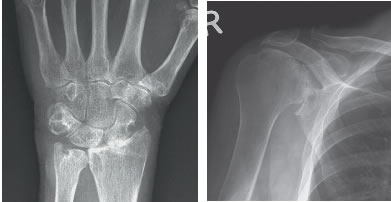
Gout (seronegative arthritis) in which an alteration in the protein metabolism resulting in either over production or reduced excretion of the by product – Uric Acid, which accumulates in small joints initially (great toe) and later may involve other joints. The normal serum uric acid is less than 5.7mg/dl in females and less than 7.7 mg/dl in males.
In aggressive case, uric acid crystal deposition in joints may cause excessive damage. Factors considered to cause gout are high protein diet, alcohol consumption, stress.
Gout can be effectively controlled with appropriate uric acid lowering diet, healthy lifestyle habits and uric acid lowering drugs such as Colchicine, Allopurinol, Febuxostat
There is a separate entity of Arthropathy apart from gout which are considered seronegative arthritis which shows inflammatory markers in the serum without of presence of RF (Rheumatoid factor). These includes
Appropriate diagnosis and early treatment of these conditions shall render a pain free and healthy life.
A complete ligament rupture requires the apposition of the divided ends followed by a period of protection if satisfactory healing is to be obtained. Depending on the situation, the injury may be treated conservatively by immobilization in a plaster – cast or, preferably, in a functional brace designed to allow joint movement whilst restricting the stresses on the healing ligament. If there is reason to doubt whether the torn ends are in apposition, the surgical suture may be advisable. Three weeks ’protection is usually sufficient to secure.
If time allows, it is usual to assess the situation before surgery by angiography. With major vessels, the suture may be possible or the vessel may have to be repaired with a vein patch or a graft, usually taken from a vein. Fasciotomy is usually necessary.
Umbness and muscular weakness developing later. The pain is typically made worse by stretching the affected muscles, which are also tender. Swelling of the ankle, foot, or hand is not necessarily a feature. Neurological signs eventually develop if the pressure is not released and in the late case the peripheral pulses may become impalpable. The presence or absence of the pulses is not, however, a good guide to the diagnosis.
Occasionally, following trauma to a limb, particularly a closed fracture or crush injury, the venous outflow from a fascial compartment may become obstructed by swelling, causing the pressure to rise gradually within the compartment. When the pressure reaches a critical level, any nerves passing through the compartment cease to function, initially causing paraesthesiae, followed by loss of sensation in the area supplied by the nerve. As the pressure continues to rise, tissue perfusion may cease, particularly in the muscles, and, rarely